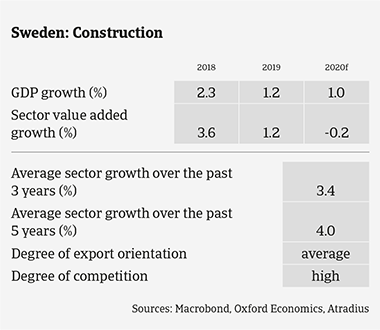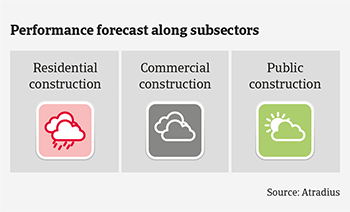Total investment in domestic construction decreased 4% in 2019.
Demand and margins of businesses remained stable in some segments like office buildings and civil engineering. However, the market for building new malls and hotels is increasingly mature.
While renovation works showed a modest decline, investment in new residential buildings sharply decreased by 14%. Restrictions for consumer credits imposed on banks by the state have curbed loans to households for house buying, and some oversupply has led to falling prices. Many residential construction bussinesses recorded deteriorating margins in 2019.
The 2020 domestic construction performance outlook remains subdued, as Sweden´s economic growth remains modest at about 1%. Investment in the residential construction subsector is set to decline further, however the decrease will be lower than in 2019 as house prices stabilise. On the other hand, investment in public construction (mainly infrastructure) is expected to increase.
Value added in the Swedish construction material segment is forecast to decrease slightly in 2020 (down 0.1%) after declining 0.7% in 2019. Consolidation in the market is ongoing, with financially stronger groups buying financially weaker businesses. In the mid-term construction materials should benefit from high renovation requirements in the housing segment.
Construction businesses are often highly indebted, especially those active in the real estate and housing construction segment. Banks are reluctant to lend to this subsector, but are more willing to provide loans to companies active in other segments.
Payment duration in the industry is 30-45 days on average. The level of protracted payments and the number of insolvencies is high compared to other industries. Both payment delays and insolvencies are expected to level off in 2020 after increasing in 2019 (construction insolvencies increased 2% year-on-year in 2019).
Our underwriting stance remains restrictive for businesses active in residential construction and for relevant subcontractors. The subsector is impacted by tighter access to bank financing and is expected to face another decrease in demand in 2020.
At the same time we are less restrictive on commercial construction. While this subsector is also facing decreasing demand, businesses and end-customers are generally financially healthier and have easier access to loans. That said, commercial real estate businesses that rent out to retailers could be negatively affected by decreasing brick-and-mortar retail sales.
We are generally neutral for the construction material segemnt and open for businesses active in public construction, where businesess are financially stronger than in other segments.

Market Monitor Construction Sweden 2020 sector growth

Market Monitor Construction Sweden 2020 performance forecast
Relaterede dokumenter

1.42MB PDF
